22 Common Tomato Plant Problems and How to Fix Them

Your customers are probably some of the three million people that planted a home garden this year, and they are most likely growing tomatoes. After all, nine out of 10 gardeners grow tomatoes.
Many of the gardeners that grow tomatoes, however, are frustrated with the progress of their plants. The plant may not set fruit. Or tomatoes may ripen, but have ugly, spongy black spots at the bottom. Worse still, these plants may look great one day and by the next morning, they’ve been attacked and essentially destroyed.
This list of 22 common tomato problems and their solutions will help you identify the issues a customer may bring up, as well as tips you can offer to help them correct it.
IDENTIFY TOMATO PLANT PROBLEMS AND DISEASES
Before diving into the list, it’s important to ask the gardener to correctly identify the problem or tomato plant disease. When trying to identify tomato plant diseases, tell your customers to use these steps:
- Identify the affected part of the plant — Is it the tomato itself, the leaves, stems, flowers or roots?
- Note differences — When comparing a problem tomato plant to a healthy plant, how does it differ? For example, a healthy tomato plant has softly fuzzed, medium-green leaves. Suffering plant leaves may have brown or black patches, holes, chewed edges or fuzzy mold growing on them.
- Look for insects — What insects are invading these plants? To identify an insect, caterpillar or mite, take a super close-up photo, note its size, the plants it’s on (besides the tomatoes) and contact your local Cooperative Extension agent to identify the insects.
Armed with this information, you can easily scan this list and narrow down the possible tomato plant disease or pest problem and how to fix it.
22 COMMON TOMATO PROBLEMS
The list is divided into three sections: 16 diseases caused by poor cultivation habits, bacteria or fungi; 5 insect-specific tomato problems; and a final section on birds and squirrels. We have also included some tips for growing delicious, healthy tomato plants so you can keep those problems away next year.
16 TOMATO PLANT DISEASES
Tomato diseases, garden fungi and certain environmental conditions can quickly cripple garden plants. Oftentimes, it is possible to rescue a tomato plant, but some circumstances may require the gardener to destroy the plant and plant another crop in its place.
Help for tomato plants
Be sure to browse the extended information below on tomato plant problems, but, overall, here are the most common disease and fungus triggers in tomato plants:
- Not enough fertilizer. (Solution: Test the soil and apply fertilizer as appropriate for the growth stage.)
- Over-pruning. (Solution: Always use a tomato cage and leave enough foliage to shield the fruit.)
- Not enough calcium. (Solution: Test the soil, apply lime and gypsum as needed.)
- Planting before temperatures raise to ideal levels. (Solution: Wait for the right planting time for your Hardiness Zone.)
- Too much water or too little water. (Solution: Water plants evenly through the growing season.)
- Watering overhead, which promotes fungal growths. (Solution: Water at the base of the plant. and apply fungicide.)
- Lack of air flow around plants. (Solution: When planting, space tomato plants at appropriate distances from one another and prune leaves (but not too much, see above) as they grow. Apply fungicide if powdery mildew appears.)
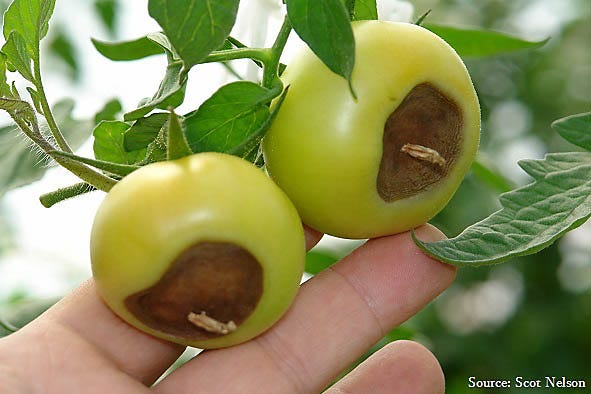
Blossom End Rot
What it looks like: The tomato plants appear healthy, but as the tomatoes ripen, an ugly black patch appears on the bottoms. The black spots on tomatoes look leathery. Inside the tomato, the fruit looks mealy.
What causes it: Plants aren’t getting enough calcium. There’s either not enough calcium in the soil, or the pH is too low for the plant to absorb the calcium available. Tomatoes need a soil pH around 6.5 in order to grow properly. This soil pH level also makes it possible for them to absorb calcium. Uneven watering habits also contribute to this problem. Hot, dry spells tend to exacerbate blossom end rot.
What customers need to do about it: Before planting tomatoes in the spring, conduct a soil test. Offer recommendations on the amendments to add to the soil. Lime and gypsum may be added for calcium, but they must be added in the proper amounts depending on your soil’s condition. That’s why a soil test is necessary. Adding crushed eggshells to a compost pile can also boost calcium when using the resulting compost. A foliar spray containing calcium chloride can prevent blossom end rot from developing on tomatoes mid-season. Apply it early in the morning or late in the day — if sprayed onto leaves midday, it can burn them. Water plants regularly at the same time daily to ensure even application of water.
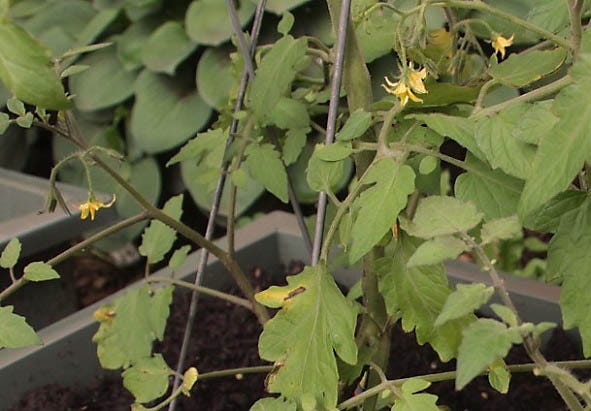
Blossom Drop
What it looks like: Flowers appear on tomato plants, but they fall off without tomatoes developing.
What causes it: Temperature fluctuations cause blossom drop. Tomatoes need night temperatures between 55 to 75 degrees F in order to retain their flowers. If the temperatures fall outside this range, blossom drop occurs. Other reasons for blossom drop on tomatoes are insect damage, lack of water, too much or too little nitrogen, and lack of pollination.
What customers need to do about it: Make sure the rest of the plant is weather-resistant by using fertilizer for tomatoes, drawing pollinators by planting milkweed and cosmos, and using neem oil insecticides.

Fruit Cracks
What they look like: Cracks appear on ripe tomatoes, usually in concentric circles. Sometimes insects use the cracks as an opportunity to eat the fruit, or birds attack cracked fruit.
What causes them: Hot, rainy weather causes fruit crack. After a long dry spell, tomatoes are thirsty. Plants may take up water rapidly after the first heavy rainfall, which swells the fruit and causes it to crack.
What customers need to do about it: Water tomatoes evenly during the growing season. This prevents them from being so thirsty that they take up too much rainwater during a heavy downpour.
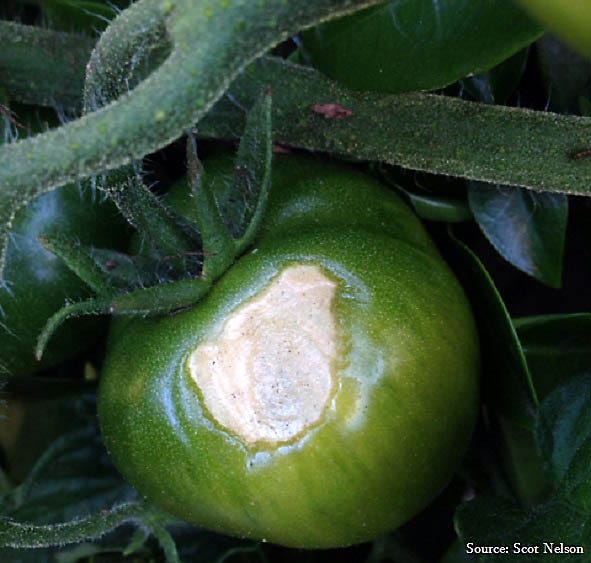
Sunscald
What it looks like: The plants look healthy, and the fruit develops normally. As tomatoes ripen, yellow patches form on the red skin. Yellow patches turn white and paper-thin, creating an unpleasant appearance and poor taste.
What causes it: As the name implies, the sun’s rays have actually scalded the tomato.
What customers need to do about it: Tomato cages, or a wire support system that surrounds the plants, give the best branch support while shading the developing tomatoes naturally. Sunscald usually occurs on staked plants that have been too-vigorously pruned, exposing many of the tomatoes to the sun’s rays. Leaving some foliage and branches provides shade during the hottest part of the day.

Poor Fruit Set
What it looks like: Plants have some flowers, but not many tomatoes. The tomatoes that develop on the plant are small or tasteless.
What causes it: Too much nitrogen in the soil encourages plenty of green leaves but not many flowers. If there aren’t enough flowers, there won’t be enough tomatoes. Another cause may be planting tomatoes too closely together. Tomatoes are self-pollinating, meaning that each flower contains both the male (stamens) and female (pistils) parts. Wind typically pollinates tomatoes, but if plants are too close together, the wind can’t reach the flowers.
What customers need to do about it: Have the soil tested. When planting tomatoes in the spring, leave at least two feet or more between plants so that good air circulation can help pollinate them. For plants already in the garden, simply shake the flowering branches to simulate wind and get the pollen from the stamens to the pistils.
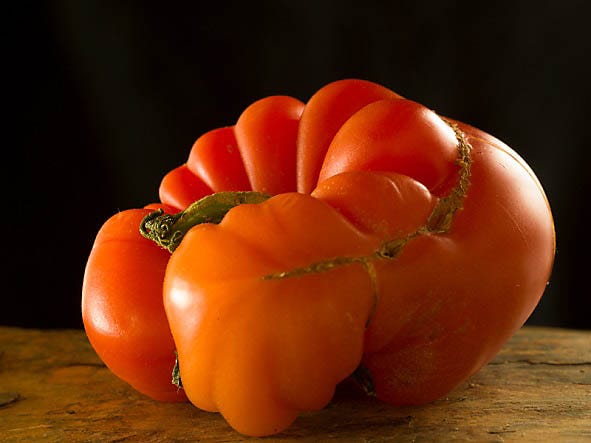
Catfacing
What it looks like: Catfacing makes tomatoes appear deformed. The blossom end is rippled, bumpy and lumpy.
What causes it: Plants pollinated during cool evenings, when the temperatures hover around 50 to 55 degrees F, are subject to catfacing. Blossoms fall off when temperatures drop too low. However, if the flower is pollinating before the petals begin to drop off, some stick to the developing tomato. This creates the lumps and bumps typical of catfacing.
What customers need to do about it: Plant tomatoes a little later in the season. Make sure the weather has truly warmed up enough to support proper tomato development. Devices such as a “Wall of Water” — a circle of water-filled plastic tubes — raise temperatures near the tomato and help keep them high enough on cold nights to prevent cold-related problems. Using black-plastic spread on the soil can also help. As the plastic heats during the day, it releases the heat back towards the plants at night. Black plastic can be used as a temporary measure until the temperatures warm up enough that it’s no longer needed.
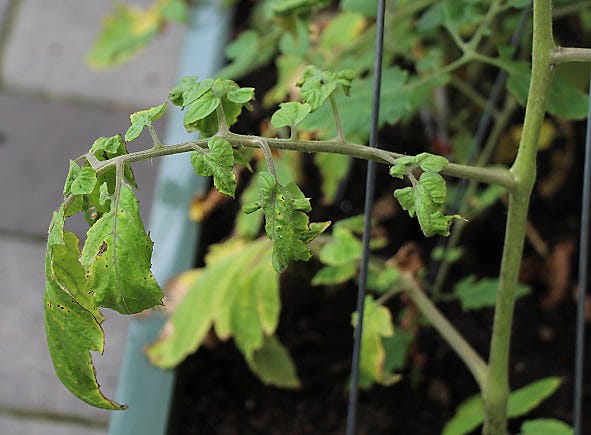
Leaf Roll
What it looks like: Mature tomato plants suddenly curl their leaves, especially older leaves near the bottom. Leaves roll up from the outside towards the center. Sometimes up to 75% of the plant is affected.
What causes it: High temperatures, wet soil and too much pruning often result in leaf roll.
What customers need to do about it: Although it looks ugly, leaf roll won’t affect tomato development, so edible tomatoes will still be available. Avoid over-pruning and make sure the soil drains excess water away.

Puffiness
What it looks like: The tomato plants look fine, they bloom according to schedule, and ripe red tomatoes are ready for harvest. When the tomato is sliced, the interior has large, open spaces and not much fruit inside. Tomatoes may feel light when harvested. The exterior of the tomato may have an angular, square-sided look.
What causes it: Under-fertilization, poor soil nutrition or inadequate pollination.
What customers need to do about it: Feed tomato plants throughout the season. A balanced fertilizer, such as a 10-10-10, should be fed biweekly or monthly. Tomatoes are heavy feeders and need fertilizer throughout the growing season. For gardeners, frequent top-dressings with homemade compost and compost teas are a must.

Bacterial Canker
What it looks like: Often confused with cloudy spot disease, bacterial cankers start as yellow dots on ripening red tomatoes. Look carefully at the spots — using a magnifying glass if available — a dark, birds-eye-type rim will be around each of the yellowed spots. This is what distinguishes bacterial canker from cloudy spot disease.
What causes it: A bacteria called Clavibacter michiganensis. The bacteria occurs naturally but can be brought into the garden on infected plants or tools. Once it gets into the soil, rainwater splashes it up onto the plants. If there’s an open sore, such as insect damage or a leaf missing from pruning, it can enter the plant and infest it.
What customers need to do about it: Remove the infected plants immediately and do not plant tomatoes again in that soil for at least three years. Rotate your crops regularly to prevent these and other diseases from taking hold in the soil. Don’t compost the dead plants — instead, put them in the trash to avoid spreading the bacteria.
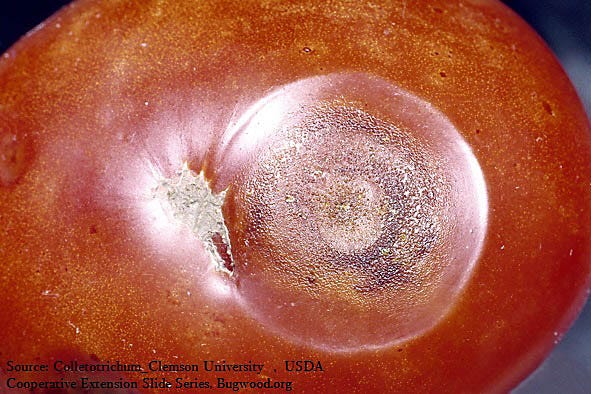
Anthracnose
What it looks like: As tomatoes ripen, a dark, bull’s-eye circle appears on the blossom end or bottom of the tomato. The spot is sunken and mushy to the touch. When you slice into the tomato, there’s a black mushy spot underneath that looks like rot.
What causes it: A fungus called Colletotrichum phomoides. The fungus loves hot, moist weather and is often spread by overhead irrigation, sprinklers striking infected soil and splashing the fungus up onto the plants, and infected plants.
What customers need to do about it: Switch watering methods so water drips on the roots, not the leaves of the plants. Harvest tomatoes when ripe, since overly ripe tomatoes tend to contract the fungus more than tomatoes in the early stages of ripening.
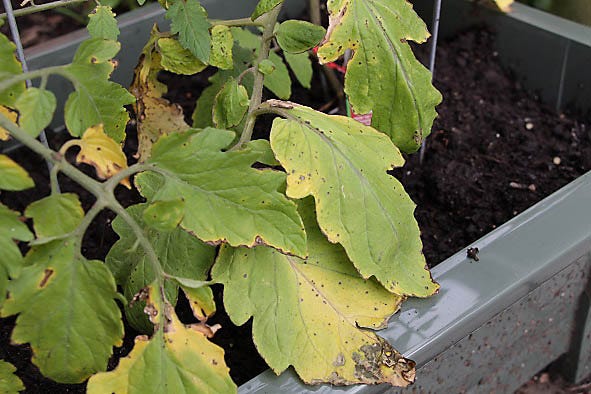
Early Blight
What it looks like: Brown spots appear on tomato leaves, starting with the older ones. Each spot starts to develop rings, like a target. Leaves turn yellow around the brown spots, then the entire leaf turns brown and falls off. Eventually the plant may have few, if any, leaves.
What causes it: A fungus called Alternaria solani triggers early blight. This fungus can live in the soil over the winter, so if plants have had problems before like this, and tomatoes are planted in the exact same spot, chances are good the same thing will happen again.
What customers need to do about it: Crop rotation prevents new plants from contracting the disease. Avoid planting tomatoes, eggplants or peppers in the same spot each year as these can all be infected with early blight. A garden fungicide can treat infected plants.
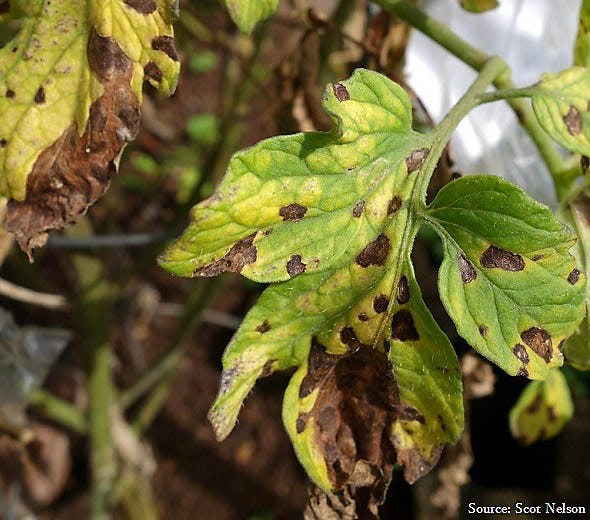
Septoria Leaf Spot
What it looks like: After the plants begin to develop tomatoes, the lower leaves break out in yellow spots. Within the yellow spots, dark gray centers with dark borders appear. Black dots appear in the center of the spots. Foliage dies and falls off.
What causes it: A fungus called Septoria lycopersici infects foliage.
What customers need to do about it: Avoid watering tomatoes from the top, as the spray can force the spores developing on the leaves back into the soil and continue the disease cycle.

Fusarium Wilt
What it looks like: Though tomato plants look fine, they suddenly start to wilt. At first, only one side may be affected, but then the whole plant is wilting. If watered, the problem gets worse. Within a day or two, the plant is dead!
What causes it: A nasty fungus called Fusarium oxysporum f.sp. lycopersici that attacks the vascular system of the plant, roughly equivalent to a human’s veins. The fungus destroys the xylem tubes, which transport water and nutrients up from the roots and into the leaves.
What customers need to do about it: In the case of fusarium wilt, the best defense is a good offense. Rotate crops so tomatoes aren’t planted in the same section of the garden each year. Purchase wilt-resistant varieties if tomatoes fell victim to wilting diseases in the past. Be warned: This fungus can overwinter in garden and lawn soils.
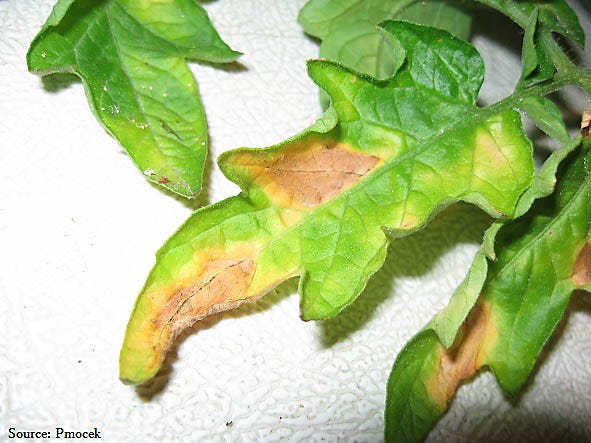
Verticillium Wilt
What it looks like: Yellow blotches appear on the lower leaves. As the blotches spread, the veins in the leaves turn brown. After the leaves turn brown, they fall off. The disease progresses up the stem until the plant is stunted.
What causes it: A fungus that lives in the soil, Verticilliurn albo-atrum, attacks the roots and travels up the xylem tubes with water. It then prevents the normal flow of water and nutrients to the leaves.
What customers need to do about it: Once plants are infected, there isn’t a good way to treat Verticillium wilt. Rotate the garden’s crops, because the fungus can live for long periods in the soil and even live among weeds such as ragweed. Choosing wilt-resistant varieties to plant is the best way to prevent Verticillium wilt.
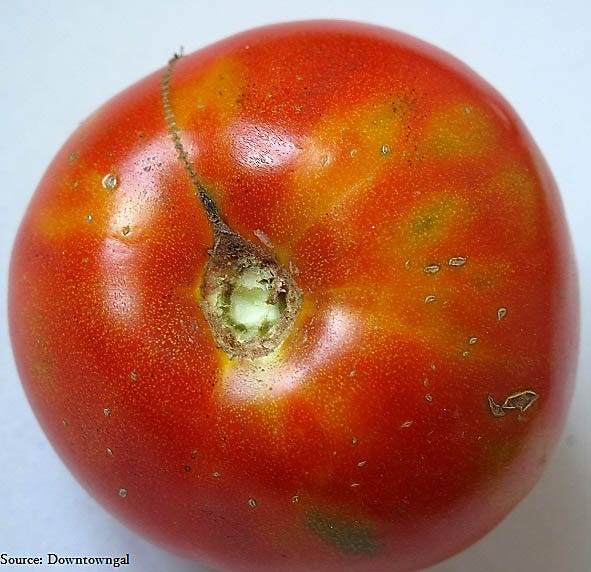
Viral Diseases
What they look like: Viral diseases mainly attack the tomatoes themselves. Black spots or weird stripes appear on the tomatoes. Don’t confuse signs of disease for just how some heirloom tomatoes look with natural stripes.
What causes them: Many of these viruses spread when plants are stressed by heat, drought or poor soil.
What customers need to do about it: Check symptoms to see if they match another tomato problem. If not, spray the tomato plants with neem oil. Good soil management and using organic fertilizer for tomatoes also helps keep plants healthy, which can help them naturally resist viruses better.
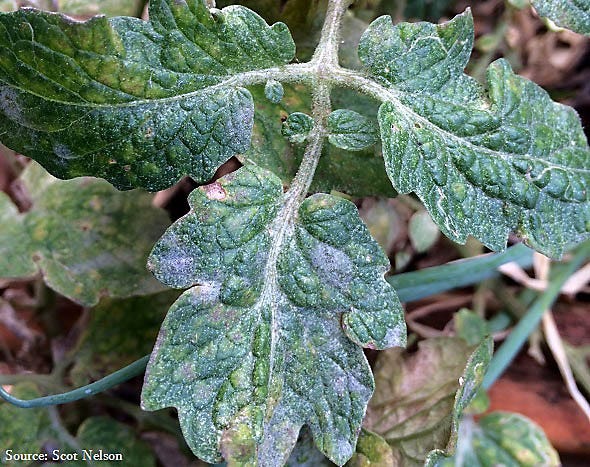
Powdery Mildew On Tomatoes
What it looks like: Powdery mildew is easy to find on tomato plants as it looks like someone brushed the leaves with a white powder. White spots on tomato leaves or even the stem may also appear. If unchecked, it will turn tomato leaves yellow and then brown.
What causes it: Powdery mildew on tomatoes is more common in greenhouses than an outdoor garden because of the lack of air flow and high humidity.
What customers need to do about it: The best way to prevent powdery mildew on tomato plants is to use a preventative spray formulated with sulfur.
5 INSECTS THAT CAN DESTROY YOUR TOMATOES
In addition to diseases, insects can damage tomato plants, too. Here are the best options for fighting insect infestations on tomato plants:
- Caterpillar Killer with B.t. (Solution: Fight hornworms and other plant-eating caterpillars with this OMRI Listed® biological control that targets destructive larvae.)
- Insect Killing Spray for Tomatoes. (Solution: An insect-killing formula for use on tomatoes that's compliant for use with organic gardening and fights tomato hornworm, Colorado potato beetles, whiteflies and other caterpillars.)
- Insecticidal Soap. (Solution: An OMRI Listed® insecticide soap that can be used up to the day of harvest on aphids, mealybugs, spider mites and other pests.)
- Insecticidal Soap with Pyrethrin. (Solution: By mixing the features of insecticidal soap and pyrethrin, gardeners maintain their organic garden and fight spider mites, hornworms and destructive beetles.)
- Neem Oil. (Solution: Neem oil kills insects in every life stage -- from eggs to adults.)
- Insect Traps. (Solution: Lure pest insects away from plants and trap them before they can do more damage.)
The following tend to be the most common causes of various tomato pest problems.

Cutworms
What they are: Cutworms feed at night on seedlings. They “cut” or eat through the stem at soil level or an inch or less above the soil. Cutworms aren’t exactly worms — they are the larvae of certain moths. They only emerge at night and can be difficult to spot. Cutworms kill tomato plants by snipping them right in half.
What customers need to do about it: Prevent cutworm damage by making a paper collar that fits around seedlings. Just take newspaper or cardboard and fold it into an inch-wide strip. Use tape to make a collar around the plant, leaving about two to three inches around the stem. Remove the collar once the plant has several sets of leaves. You can also cut the bottom off a paper cup and slide the open-bottom cup over the seedling to prevent cutworm damage.
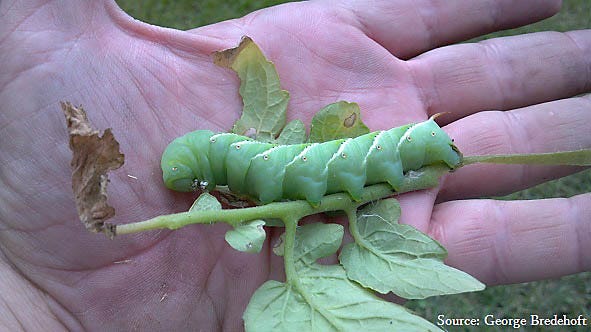
Hornworms
What they are: Tomato or tobacco hornworms can decimate mature tomato plants in one night. These insects are large green worms about two to three inches long with tiny horns on their head and ridged bodies. Hornworms are perfectly camouflaged so they look exactly like a tomato stem or branch, making them difficult to spot. They emerge at night, eat all the leaves off the plant and move on to the next section or plant.
What customers need to do about it: Nature provides the best control for tomato hornworm in the form of a parasitic wasp that lays her eggs on the body of the hornworm. As the wasp’s larvae hatch, they eat into the living worm and eventually kill it. Natural methods to control tomato hornworms include planting marigolds around tomatoes. The strong marigold scent repels them. Safer® Brand Caterpillar Killer II With B.T. uses a naturally occurring fungus to quell hornworms without harming earthworms. Also, try an insect-killing spray.

Colorado Potato Beetle
What they are: Colorado potato beetles are native to the United States. They love plants in the nightshade family, especially potatoes. If they can’t find potatoes, however, they will gravitate towards tomatoes, eggplant and other nightshade family vegetables. The beetles are about the size of dimes, with yellow-and-black striped wings. The adults use their mouthparts to chew holes in the leaves of tomato plants. Females lay clusters of bright gold or yellow eggs underneath the leaves. When the larvae hatch, they spread out among the tomato leaves, easily eating their way through the entire plant. Larvae are red to dark pink with black spots and frequently hide under the leaves during the day.
What customers need to do about it: Use a pesticide with pyrethrins to spray on tomato plants. This method works best in early spring before the larvae mature.

Stink Bugs
What they are: The brown marmorated stink bug isn’t only an annoyance inside the home. These insects also use their needle-like mouthparts to suck the juice right out of tomatoes. They can be spotted with the naked eye on tomatoes. Also, look for their damage in the form of yellow, uneven spots that appear on the ripening tomatoes. When slicing into a yellow-spotted tomato, white sections appear under the yellow spots, which distinguish stink bug damage from fungal or viral problems.
What customers need to do about it: Safer® Brand makes stink bug traps that harmlessly attract the insects to the trap and away from your tomatoes.
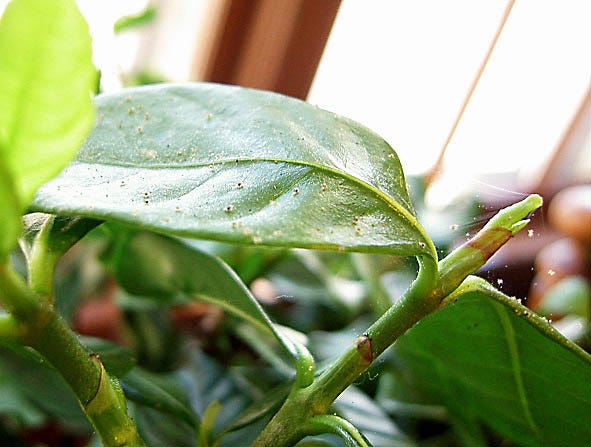
Spider Mites
What they are: Spider mites are difficult to see because they’re so tiny, but you can clearly see the damage they leave behind. Mites scuttle along the stems and leaves, piercing the leaves to feed on the juices. Eventually, tomato leaves look stippled and bronzed, with damage to the plant’s leaf structure.
What customers need to do about it: The best method for treating spider mites on tomato plants is to use a neem oil spray. Another option is insecticidal soap, which also offers a treatment for spider mites.
NOT JUST BUGS: BIRD PROBLEMS
One final tomato problem is often mistaken for insect damage: birds. Some birds, especially crows, love to eat ripening fruit, and tomatoes are technically a fruit. Crows peck with their large, sharp beaks at the ripening tomatoes, ripping open gashes and eating partial segments from various fruits. Other birds and even squirrels may also be at work if you find tomatoes that look like they have bites taken out of them.
The best control for bird problems is a net. A large fruit tree net, available at your local home or garden store, can be draped over the plants. The net is an effective deterrent to birds and usually a good deterrent for squirrels, too.
